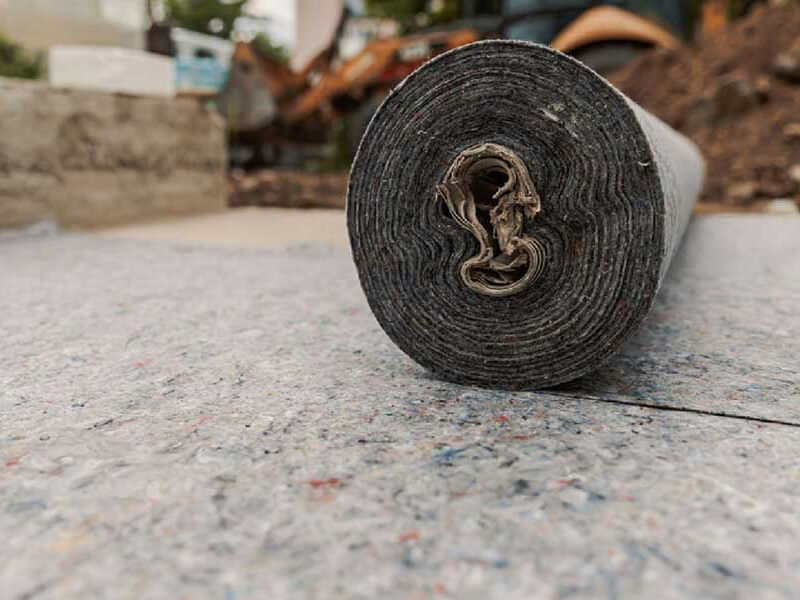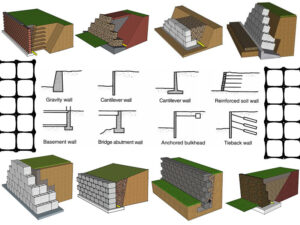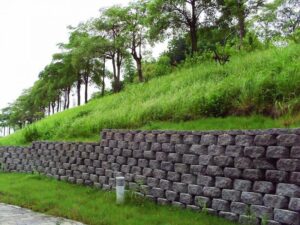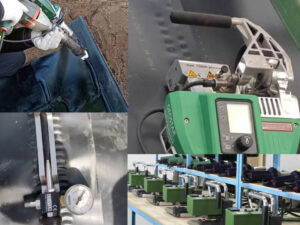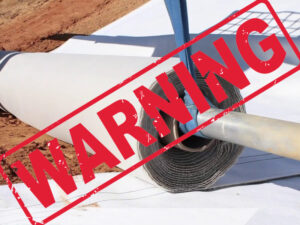This article provides foundational information about geotextile fabric. Throughout the text, QIVOC will extensively introduce you to this product. If you want to gain a deeper understanding of geotextile fabric, this article is highly suitable for your reading. Feel free to click the link below to navigate to the specific section you wish to explore.
Table of Contents
What Is Geotextile?
Geotextile, also known as geotextile fabric material or geotextile membrane, is a permeable synthetic material made from synthetic fibers (such as polypropylene or polyester) through needle punching or weaving. Functioning as a permeable textile, when used in conjunction with soil, it possesses the abilities of separation, filtration, reinforcement, protection, or drainage. Consequently, it finds extensive applications in civil engineering and various construction projects, aiming to fulfill specific functions in geotechnical and environmental applications.
It primarily exists in two fundamental forms: woven fabric (similar to mailbag burlap) and non-woven fabric (similar to felt). Non-woven geotextile fabric is commonly employed for filtration and drainage, while woven geotextile fabric is crucial for applications requiring strength and reinforcement.
What Are The Types of Geotextiles?
Geotextile fabric is primarily composed of natural and synthetic fibers, with synthetic fibers being the most commonly used. Natural fibers include jute, coconut husk, hemp, and others, while synthetic fibers predominantly utilize materials such as polyester and polypropylene (which are also raw materials for plastic production, though geotextile fabric and plastic differ significantly). Depending on the manufacturing process of geotextile fabric, it is mainly categorized into the following types, each possessing its characteristics and advantages.
Woven Geotextile Fabric:
Woven geotextile is crafted from yarns intricately interwoven in a regular pattern. Due to its uniform distribution, it exhibits outstanding strength and dimensional stability compared to non-woven geotextile fabric. Primarily employed to prevent soil movement, restrict underground drainage, and reinforce texture control, these fabrics are also utilized in stabilizing railway tracks.
Non-Woven Geotextile Fabric:
Non-woven geotextile is manufactured from thermally bonded synthetic fibers, offering lightweight and pliable characteristics. Primarily used for separation and filtration applications, reinforcing retaining walls, soil stabilization, and erosion control, non-woven fabrics possess permeability, excellent puncture resistance, moderate tensile strength, and impressive elongation properties.
Polypropylene Geotextile Fabric:
Polypropylene geotextile fabric is a non-woven fabric primarily designed for separation. While they possess permeability and drainage capabilities, they do not provide any reinforcement for projects. Polypropylene geotextile fabric is commonly referred to based on its lifespan and is frequently used as a weed barrier.
Spunbond Geotextile Fabric:
In the realm of fabric manufacturing, the spunbond process is considered the fastest method for producing non-woven fabric. In this process, extruded filaments are spun into sheets and bonded through heated rollers. Similar to polypropylene geotextile fabric, spunbond fabrics offer drainage capabilities but lack reinforcement. Calculated by weight, they are typically used as weed barriers or drainage fabrics.
Knitted Geotextile Fabric:
These textiles exhibit excellent flexibility and high cost-effectiveness. Despite their lower usage, the demand for “drainage and erosion control” is steadily increasing. Knitted geotextile fabrics are produced using knitting techniques, and sometimes weaving is also employed in their manufacturing.
Composite Geotextile Fabric:
These are created by combining two or more geotextile fabrics to form a material with unique properties. For instance, composite geotextile fabrics may combine non-woven geotextile fabric with woven geotextile fabric to produce a sturdy, durable, and highly permeable material.
Polyester Geotextile Fabric:
Polyester geotextile fabric is made from curled short fibers of polyester, with a fiber fineness of 6-12 deniers and a length of 54-64 millimeters. The production process involves opening, carding, blending (interlacing short fibers), web laying (standardized knotting and fixing), and needle-punching techniques using non-woven fabric production equipment to create the fabric.
Polyester Filament Geotextile Fabric:
Polyester filament geotextile fabric is made from polyester geotextile fabric material through spinning and needle punching. It exhibits excellent heat resistance and light resistance.
Continuous Filament Geotextiles:
These geotextiles are made from continuous fibers without the need for individual yarns or staple fibers. Continuous filament geotextiles are used for applications where high tensile strength and filtration are essential.
Biodegradable Geotextiles:
Biodegradable geotextiles are designed to break down over time, providing temporary support while vegetation is established. Commonly used in environmentally sensitive areas, these geotextiles help control erosion until natural vegetation takes over. Such as geotextiles made of natural fibers.
How Does Geotextile Fabric Work?
The working principles of geotextile fabric can be analyzed from three aspects, including filtration, reinforcement, and isolation.
Filtration:
Geotextile fabric exhibits excellent filtration capabilities. When water flows from a fine-grained soil layer to a coarse-grained soil layer, the geotextile fabric’s good permeability allows water to pass through while effectively retaining soil particles, fine sand, small stones, etc.
Reinforcement:
Geotextile fabric enhances the tensile strength and deformation resistance of the soil, increasing the stability of construction structures and improving the quality of the soil. It can effectively diffuse, transfer, or decompose concentrated stress, preventing soil from being damaged by external forces.
Isolation:
Geotextile fabric isolates construction materials with different physical properties (such as small particle size, distribution, density, etc.), such as soil and sand, sand and gravel, soil and concrete. This prevents loss and mixing between two or more materials, maintaining the overall structure and functionality of the materials and strengthening the load-bearing capacity of structures.
Does Geotextile Fabric Clog?
Geotextile fabric possesses excellent three-dimensional permeability, enabling it to form drainage channels within the soil. It gathers moisture from the soil, directing it horizontally along the plane of the material and then draining it out horizontally, without clogging, creating a horizontal drainage layer. Thicker needle-punched non-woven geotextile fabric and certain composite geotextile synthetic materials with more pores can serve a drainage function.
Validation of the drainage function of geotextile fabric:
During the construction of the diffusion section of a drainage sluice project, a significant amount of seepage was observed in the excavated foundation pit. To address this, drainage and pressure relief measures were taken. Geotextile fabric was laid beneath the excavation, covered with crushed stones, and drainage pipes were installed to release water through the bottom plate before pouring the concrete slab. Additionally, retaining walls were constructed for the downstream drainage channel. The project was successfully completed, and several years of operation have shown no signs of deformation, validating the feasibility of the drainage function of geotextile fabric.
In other applications, geotextile fabric can also cut off the capillary rise of water in frost-prone and saline-alkali areas, reduce groundwater levels, and play a role in preventing freezing and alkali effects. In highway subgrades, geotextile fabric in the isolation layer can also contribute to drainage.
Why Use Geotextile Membrane?
Geotextile fabric possesses numerous advantages that contribute to its extensive application in daily life and engineering projects.
- High Strength: Geotextile fabric, made from plastic fibers, maintains sufficient strength and elongation in both dry and wet conditions.
- Corrosion Resistance: It exhibits long-term corrosion resistance in soils and water with varying levels of acidity and alkalinity.
- Good Permeability: The presence of gaps between fibers provides excellent drainage and permeability.
- Biostability: Geotextile fabric is resistant to damage from microorganisms and pests, effectively preventing weed growth and serving as an efficient weed barrier.
- Easy Construction: Its lightweight and flexible nature facilitates easy transportation, laying, and construction.
- Aging Resistance: Geotextile fabric boasts a long lifespan, easily surpassing 50 years.
- Non-Flammable: Geotextile fabric contains flame retardants, effectively preventing it from catching fire.
Therefore, the lightweight, cost-effective, corrosion-resistant, and high-performance properties, including filtration, drainage, isolation, and reinforcement, make geotextile fabric widely used in construction projects such as road construction and dam protection.
Is Geotextile Fabric Biodegradable?
The biodegradability of geotextile fabric depends on its manufacturing materials. Most chemically synthesized materials are challenging for nature to break down and can only be recycled through artificial means. On the other hand, naturally biodegradable materials must be carbon-based biomaterials, such as natural fiber geotextile.
Natural fiber geotextile is made from robust plant fibers like cotton, flax, coconut husk, and straw, processed through various production techniques.
This type of geotextile is widely used in artificial grass planting, urban landscaping, and desert edge management.
The raw materials for natural fiber geotextile are sourced from nature, making it environmentally friendly. Despite its relatively lower durability, it easily undergoes microbial degradation after use. Not only does it not pollute or harm the environment, but it also provides suitable feed for certain plants. Additionally, the mechanical and hydraulic properties that synthetic fibers possess are also present in natural fiber geotextile.
What Does Geotextile Fabric Do?
Geotextile fabric boasts numerous applications, making it a vital component in a wide range of construction and environmental settings due to its versatility.
- Separation material for soil layers and filtration purposes.
- Drainage material for reservoirs, mining operations, and foundations of high-rise buildings.
- Erosion control material for riverbanks, dams, and slope protection.
- Reinforcement material for railway, highway, and airport runway subgrades, as well as stabilization material for road construction in swampy areas.
- Insulation material for frost and freeze prevention.
- Anti-cracking material for asphalt road surfaces.
Geotextile fabric is applicable in the following areas and many more:
- Reinforcement in backfilling for retaining walls or as panels for anchoring retaining walls.
- Strengthening flexible road surfaces, repairing cracks in roads, and preventing reflective cracking on road surfaces.
- Enhancing the stability of gravel slopes and reinforced soil, preventing soil erosion, and frost damage in low temperatures.
- Isolation layer between road gravel and subgrade, or between subgrade and soft foundation.
- Isolation layer between artificial fill, rock piles, or material yards and foundations, as well as between different frozen soil layers, providing filtration and reinforcement.
- Initial upstream dam surface filtration layer for ash storage dams or tailings dams, and filtration layer for drainage systems in backfilled retaining walls.
- Filtration layer around drainage pipes or gravel drainage ditches.
- Filtration layer for water wells, pressure relief wells, or inclined pressure pipes in hydraulic engineering.
- Isolation layer for geotextile fabrics between highways, airports, railway embankments, and artificial rock piles, and foundations.
- Internal vertical or horizontal drainage in earth dams dissipates pore water pressure buried in the soil.
- Drainage behind or beneath concrete protective surfaces in earth dams or embankments.
- Mitigating tunnel perimeter seepage, reducing external water pressure on the lining, and controlling seepage around structures.
- Drainage for artificial fill foundations in sports fields.
- Reinforcing weak foundations in projects such as highways (including temporary roads), railways, embankments, earth-rock dams, airports, and sports fields.
What Can I Use Instead of Geotextile Fabric?
Geotextile fabric is not an obligatory choice in construction projects, as there are various alternatives available. However, geotextile fabric, being a specialized geotechnical material, offers significant advantages that alternatives cannot match.
Carpet:
Carpet can serve as an alternative to geotextile fabric due to its moderate cost and easy installation. Additionally, carpets demonstrate good drainage capabilities and can withstand a certain degree of pressure.
Waterproof Coatings:
This material forms a protective film on the soil surface, effectively preventing soil erosion and damage from water. Waterproof coatings are relatively cost-effective and easy to install.
Polyethylene Film:
Polyethylene film is a feasible alternative with good waterproofing properties, creating a barrier on the soil surface to protect soil and plants from harm. It is economically practical with lower costs and installation difficulty.
Geomembrane:
While geomembranes lack the permeability of geotextile fabric, they often provide superior tensile strength, impermeability, and corrosion resistance. However, geomembranes may not be suitable for all situations requiring water drainage.
Fiberglass Grid Cloth:
This material is stronger and more resistant to compression and tension than geotextile fabric, but it is relatively brittle and requires careful handling during construction.
Plastic Film:
The plastic film offers impermeability, moisture resistance, and insulation but lacks the mechanical strength of geotextile fabric. It cannot withstand significant water pressure and loads.
Burlap and Hemp Rope:
In small-scale projects, old burlap bags, and hemp ropes can be alternatives to geotextile fabric, but their durability may not meet the requirements of large-scale projects.
Agricultural Fabric:
Agricultural fabric can be used for covering but is often made from low-quality materials, making it unsuitable for prolonged and extensive use.
Polyester Non-Woven Fabric:
A new type of geotechnical material, polyester non-woven fabric, can replace traditional geotextile fabric and geotextile membranes. It offers high tensile strength, water permeability, and breathability, effectively reducing foundation settlement and preventing surface permeation. However, the relatively higher cost makes it unsuitable for low-cost engineering projects.
Metal Grids:
Metal grids can enhance the tensile strength and waterproofing properties of materials, suitable for constructing structures such as dams and impermeable walls.
Polymer Foam:
Polymer foam exhibits excellent thermal insulation and waterproofing properties, making it suitable for creating insulation barriers and protective embankments.
While these materials can substitute for geotextile fabric in cases of shortage or oversight, the specific choice should be determined based on the particular requirements of each application.
How To Install or Use Geotextile Fabric?
Installation of geotextile involves the following steps: calculation, cutting, laying, and sewing. QIVOC will provide a detailed explanation below.
Calculation
This step mainly involves determining the size of the geotextile.
Firstly, according to the construction drawings of various projects and the design requirements, the length of the geotextile to be cut on the dam top is determined along the cross-section of the soil embankment. Then, using the Pythagorean theorem c² = a² + b², the length of the slope of the inner slope of the soil embankment is calculated. Afterward, the length of the geotextile inside the stone trench is calculated. The sum of these three lengths equals the calculated length of the geotextile along the cross-section of the dam. To prevent the geotextile from being torn when subjected to force, a proper margin should be left during cutting.
Once the length of the geotextile is determined, the protective sections of the soil dam base and circular head are drawn on a plan at a scale of 1:100. Based on the plan and the width of the geotextile, the number of pieces of geotextile after sewing is determined through cutting and material determination.
Based on several experiences in geotextile construction, it is found that a width of 20m is appropriate for each piece of geotextile after sewing. Too narrow a geotextile leads to more laying and stitching, causing waste and inefficiency. Too wide a geotextile makes transportation and laying difficult.
For the cutting of the circular head, first, calculate the semi-circumference of the circle using the formula c=2πr/2. This gives the length of the outer line of the geotextile laid on the circular head. Then, based on the cutting width of the geotextile, use a compass at a scale of 1:100 along the outer line of the geotextile on the circular head to draw the number of geotextile cuts needed. Afterward, based on the number of cuts on the bottom, along the upper edge of the geotextile on the circular head, determine the width of each cut on the upper edge.
Cutting
When cutting geotextiles, it is essential to use sharp blades or similar tools. Avoid using scissors to cut it bit by bit, as this can easily cause fabric stretching and result in strength damage during the cutting process.
Cut the geotextile according to the calculated size requirements.
Precision is crucial during the cutting process. Ensure a seam length of 15 centimeters, a seam width of 15 centimeters, and a central width of 30 centimeters. During product construction, leave a 10-centimeter-wide seam tape on all three sides, except for the anchor end, for connecting film to film.
Laying
Ensure the construction area is flat and solid, addressing any foreign objects appropriately.
Determine the geotextile size based on site conditions and cut it accurately before laying.
Roll out and spread the geotextile manually, ensuring a smooth cloth surface and leaving adequate allowance for deformation.
Verify the width appropriateness, ensuring smooth and moderately tight overlaps.
Ensure that joints intersect with the slope line. In areas balanced with the slope foot or subject to stress, maintain a distance of more than 1.5m between horizontal joints.
On slopes, anchor one end of the geotextile and gently roll it down to maintain tautness.
Secure all geotextiles with sandbags during laying, retaining them until the top layer of material is placed.
For filament or short-filament geotextiles, use methods like overlapping, sewing, and welding during installation. The width of stitching and welding should generally exceed 0.1m, and the overlap width should be more than 0.2m. Geotextiles exposed for an extended period should be welded or stitched.
Employ a hot air gun to bond overlapping parts of two geotextiles, ensuring appropriate spacing between bonding points. When suturing overlaps, use materials resistant to chemical damage and UV irradiation. Maintain straight and even stitches.
After sewing, inspect the geotextile for flatness and defects. Address any issues promptly during repairs. When patching holes or cracks, use patch material consistent with the geotextile, extending at least 30 cm beyond the damaged area.
Connecting Multiple Pieces of Geotextile
Geotextiles are typically connected using methods such as overlap, sewing, and welding. The widths of sewing and welding are generally above 0.1m, while the overlap width is usually above 0.2m.
Overlap:
Geotextile on the soil membrane is naturally overlapped, with a minimum width of 20cm for natural overlap.
Sewing:
For sewing connections, a special sewing machine is used for double-thread sewing, and sewing thread resistant to chemical and ultraviolet radiation is employed.
All sewing must be continuous (e.g., spot stitching is not allowed). Before overlapping, the geotextile must overlap by at least 150mm. The minimum stitching distance from the selvage (the exposed edge of the material) is at least 25mm.
The stitched geotextile seam must include a row of chain stitches with lock stitching. The thread used for sewing should be a resin material with a minimum tensile strength exceeding 60N and chemical corrosion resistance and UV resistance equal to or exceeding that of the geotextile.
Any “missed stitches” on the sewn geotextile must be re-stitched in the affected area.
Welding:
Hot air welding is the preferred method for connecting long-fiber geotextiles. It involves instantaneously heating the connection of two pieces of fabric with a hot air gun, partially melting them, and immediately using a certain external force to firmly bond them together. Hot bonding cannot be performed in humid (rainy or snowy) weather.
Precautions
Vehicles should avoid making sharp turns or sudden brakes when driving on geotextile, especially during the paving of asphalt layers. Any abrupt turns or skidding may lift or damage the geotextile.
Construction should be avoided during rainy, damp, or cold weather conditions, as these can impact the bonding strength of coatings and the effectiveness of the cover surface.
Traffic must be closed during the laying process. Except for construction vehicles, other vehicles are only allowed to travel on geotextile in emergencies.
Where To Buy Geotextile Fabric and How Much Is It?
Purchasing geotextile is straightforward and convenient, depending on your buyer profile.
For individual buyers looking to enhance their home gardens, renovate houses, or work on small-scale drainage projects, it’s easy to purchase small quantities of geotextile on platforms like Amazon (as many manufacturers have minimum order requirements of at least 5000 square meters). Keep in mind that geotextile available on platforms like Amazon may be slightly more expensive compared to purchasing directly from manufacturers. Of course, you can also consult with us for purchasing.
If you represent various corporate engineering projects, it is recommended to procure geotextile from reputable suppliers and manufacturers.
Certainly, you have the option to purchase geotextiles from QIVOC. We offer high-quality and cost-effective geotextile, providing free engineering solutions and post-purchase guidance. With no minimum order requirements, you can benefit from our meticulous service and support regardless of the quantity you need.
The price of geotextile is influenced by the following factors:
Raw Material Costs:
Fluctuations in the prices of raw materials, such as polypropylene or polyester, impact the price of geotextile.
Production Processes:
The production processes for polyester short-fiber needle-punched geotextile and polypropylene short-fiber needle-punched geotextile involve carding and needle-punching, which are relatively simple. On the other hand, polyester long-fiber geotextile is made using the method of molding and solidification of polyester long fibers. Different production processes result in variations in geotextile prices.
Specifications:
Generally, wider geotextile widths and higher weights correspond to higher prices for the respective geotextile.
Seasonal Impact:
During the high temperatures of summer or flood prevention periods, various hydraulic engineering projects are initiated, requiring a substantial amount of geotextile. Consequently, the price of geotextile tends to rise during these times. At other times, the price of geotextile remains relatively stable.
Here is the price range table for geotextile sold by QIVOC, provided for your reference.
| Geotextile Density | Price Period |
| 100g/m2 | $0.10-$0.20 |
| 200g/m2 | $0.22-$0.35 |
| 300g/m2 | $0.36-$0.44 |
| 400g/m2 | $0.52-$0.65 |
| 500g/m2 | $0.66-$0.76 |
Is Geotextile Fabric The Same as Landscape Fabric?
“Geotextile” and “landscape fabric” are often used interchangeably, but they refer to different types of fabrics with similar functions. Both types of fabrics can be used for landscaping and construction projects to address issues such as weed control, soil stabilization, and drainage improvement. Therefore, landscape fabric can be considered as a category within geotextiles.
The specific differences between them are as follows:
Geotextile:
Geotextile covers a variety of fabrics used in civil engineering and geotechnical engineering applications. This includes road construction, erosion control, and retaining wall construction. It also encompasses various types of geotextiles, such as woven geotextiles and non-woven geotextiles, each with specific characteristics suitable for different applications.
Landscape Fabric:
Landscape fabric is a type of geotextile specifically designed for landscaping purposes. It is commonly used as a barrier to prevent sunlight from reaching the soil, thereby suppressing weed growth. Good landscape fabric allows water to pass through, aiding in maintaining soil moisture and drainage.
Is Geotextile Fabric the Same as Weed Barrier?
When the purpose is to suppress weed growth, both geotextiles and weed barriers refer to the same type of product. However, geotextiles typically encompass products referred to as weed barriers or weed control fabrics.
Both geotextiles and weed barriers are usually permeable, allowing water to reach the soil, but they form a barrier that prevents sunlight from reaching the ground. By blocking sunlight, weed seeds are less likely to germinate, and the growth of existing weeds is also inhibited.
When purchasing weed barriers or geotextiles for landscaping purposes, you may encounter products labeled as “weed control fabric,” “weed barrier fabric,” or “landscape fabric.” It’s worth noting that different products may have varying degrees of permeability, durability, and other characteristics. When choosing a weed barrier or geotextile, consider factors such as the specific requirements of your project, soil type, and the intended use of the fabric.
In The End
In this article, we delved into various aspects related to geotextiles and provided detailed answers. Feel free to bookmark it for future reference. Additionally, if you are considering purchasing geotextiles, please don’t hesitate to contact us. If you have any further questions, feel free to comment in the section below.
Lastly, remember our brand: QIVOC. We are dedicated to delivering high-quality products and ensuring customer satisfaction to the fullest extent possible.
References
en.wikipedia.org/wiki/Geotextile
baike.baidu.com/item/%E5%9C%9F%E5%B7%A5%E5%B8%83/4706916#2

